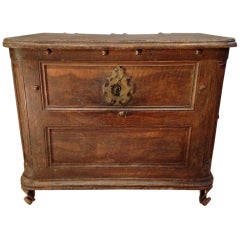17 Th Trunk
Recent Sales
Antique 18th Century and Earlier French Louis XIV Commodes and Chests of...
Iron
17 Th Trunk For Sale on 1stDibs
How Much is a 17 Th Trunk?
A Close Look at louis-xiv Furniture
As opposed to the styles that would follow from the other 18th-century French kings, Louis XV and Louis XVI, antique Louis XIV furniture is rigid and imposing. It expresses opulence — even its armchairs, with their upright backs, straight legs and lavish ornamentation, look like thrones. Authentic Louis XIV sofas, a then newly emerging iteration of seating, are fully upholstered and often feature decoratively carved frames of walnut, chestnut or oak.
When French King Louis XIV established his royal court at Versailles in 1682, he transformed what was once a hunting lodge into a palace that declared his wealth and power through its design. Until his death in 1715, he reigned with a spirit of excess and absolute political dominance. The “Sun King,” as he called himself, believed that France revolved around him as planets do the sun. Louis XIV adopted the sun as his emblem, decorating the grounds with symbols of the sun and Apollo, the Greek god of the sun. As he stated, “There is nothing that indicates more clearly the magnificence of great princes than their superb palaces and their precious furniture.” He was a child when he became king in 1643, only shaping his style after he became absolute monarch in 1661.
Reflecting trends in French Baroque art, Louis XIV furniture characteristics included exuberant decoration. There were gilded bronze details including shells, suns, grotesques, lions and classical references like acanthus leaves. The years of growth in the country’s manufacturing, such as the tapestries and cabinets made at Gobelins, led to design innovations. The commode replaced the chest as a storage device, with drawers and a surface that could double as a desk.
The materials were luxurious, such as the popular tortoiseshell veneer technique that leading cabinetmaker Pierre Golle used in his designs. André-Charles Boulle, who became royal cabinetmaker in 1672, was a masterful artist of marquetry, using inlays of ebony, exotic woods and mother-of-pearl.
Find a collection of antique Louis XIV bedroom furniture, chairs, tables and other pieces on 1stDibs.
Finding the Right commodes-chests-of-drawers for You
Is it a commode or a chest of drawers?
Commode is the French term for a low chest of drawers, but it is also sometimes used to denote a piece with a particularly intricate design. The commode dates to circa 1700 France, where it was used as an alternative to a taller cabinet piece so as to not obscure paneled, mirrored or tapestried walls. Coffers, or chests, which were large wooden boxes with hinged lids and sometimes stood on ball feet, preceded chests of drawers, a fashionable cabinet furnishing that garnered acclaim for its obvious storage potential and versatility.
As time passed, French and British furniture makers led the way in the production of chests of drawers, and features like the integration of bronze and ornamental pulls became commonplace. Antique French commodes in the Louis XV style were sometimes crafted in mahogany or walnut, while an Italian marble top added a sophisticated decorative flourish. This specific type of case piece grew in popularity in the years that followed.
So, what makes a chest of drawers different from a common dresser? Dressers are short, and chests of drawers are overall taller pieces of furniture that typically do not have room on the top for a mirror as most dressers do. Tallboys and highboys are variations of the dresser form. Some chests of drawers have one column of four to six long drawers or three long drawers in their bottom section that are topped by a cluster of small side-by-side drawers on the top. To further complicate things, we sometimes refer to particularly short chests of drawers as nightstands.
Even though chests of drawers are commonly thought of as bedroom furniture to store clothing, these are adaptable pieces. A chest of drawers can house important documents — think of your walnut Art Deco commode as an upgrade to your filing cabinet. Nestle your chest near your home’s front door to store coats and other outerwear, while the top can be a place to drop your handbag. Add some flair to your kitchen, where this lovable case piece can hold pots, pans and even cookbooks.
When shopping for the right chest of drawers for your home, there are a few key things to consider: What will you be storing in it? How big a chest will you need?
Speaking of size, don’t dream too big. If your space is on the smaller side, a more streamlined vintage mid-century modern chest of drawers, perhaps one designed by Paul McCobb or T.H. Robsjohn-Gibbings, may best suit your needs.
At 1stDibs, we make it easy to add style and storage to your home. Browse our collection of antique and vintage commodes and chests of drawers today.
